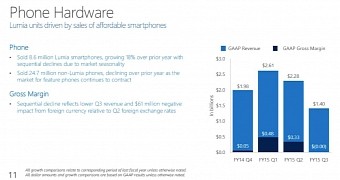Microsoft today revealed its financial results for the third quarter of fiscal year 2015, announcing a profit drop of 12 percent as compared to the same period of the previous year.
One of the most interesting topics of its earnings conference, however, was the performance of its phone business, as the company is now working at full speed not only to revamp its mobile operating system, but also to bring as many new devices to the market as possible.
Microsoft said that it sold a total of 8.6 million Lumia smartphones during the quarter, which represents an 18 percent growth over the same quarter of the previous year. Revenue reached $11.4 billion during the quarter, which represents a decline of 16 percent compared to the same quarter of FY2014.
As far as non-Lumia devices are concerned, Microsoft said that it sold a total of 24.7 million phones, but these figures are dropping, it adds, “as the market for feature phones continues to contract.”
Dissecting the figures
So basically, we have more Lumia phones sold in the third quarter of FY2015, but overall, there’s a revenue decline of 16 percent, which means that despite the fact that Microsoft actually managed to sell more units, it brought in less cash.
Despite losing money on this, Microsoft is definitely playing the winning card this time because lately, the company has been mostly about budget models that are supposed to help it gain share.
At the same time, low-end phones are supposed not only to help Windows Phone become more popular across the world, but also compete against cheap Android devices, and thus steal some users from what’s currently the world’s leading mobile platform.
On the other hand, Microsoft is all quiet on flagships, which are usually more expensive and obviously sell in smaller numbers. Flagships aren’t Microsoft’s top priority right now and it’s easy to see why: until Windows 10 comes out, it needs to increase the market share of its mobile OS as much as possible and thus generate a friendlier climate for the new platform.
There are already two flagships on the market, namely the Lumia 1520 and Lumia 930, one older and the other one newer, and although they’re both great devices, their sales were not the ones driving Windows Phone forward. Statistics show that Lumia 520, which has been Microsoft’s most affordable phone for a long time, is still the number one Windows Phone device across the world.
As far as new high-end devices are concerned, Microsoft is planning to bring new such phones to the market later this year when Windows 10 is ready. Successors to both the Lumia 930 and Lumia 1520 are expected, but details are still unconfirmed right now.
Overall, Microsoft appears to be doing everything for bigger market share in the smartphone battle these days and despite the loss, it goes forward with its increased focus on budget models. It remains to be seen if this strategy pays off on the long term.

 14 DAY TRIAL //
14 DAY TRIAL //